Related Research Articles

Prospero Alpini was a Venetian physician and botanist. He travelled around Egypt and served as the fourth prefect in charge of the botanical garden of Padua. He wrote several botanical treatises which covered exotic plants of economic and medicinal value. His description of coffee and banana plants are considered the oldest in European literature. The ginger-family genus Alpinia was named in his honour by Carolus Linnaeus.
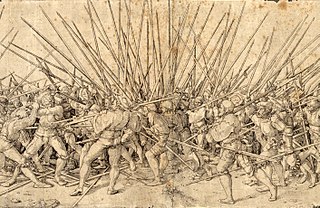
1544 (MDXLIV) was a leap year starting on Tuesday of the Julian calendar, the 1544th year of the Common Era (CE) and Anno Domini (AD) designations, the 544th year of the 2nd millennium, the 44th year of the 16th century, and the 5th year of the 1540s decade. As of the start of 1544, the Gregorian calendar was 10 days ahead of the Julian calendar, which was the dominant calendar of the time.

Conrad Gessner was a Swiss physician, naturalist, bibliographer, and philologist. Born into a poor family in Zürich, Switzerland, his father and teachers quickly realised his talents and supported him through university, where he studied classical languages, theology and medicine. He became Zürich's city physician, but was able to spend much of his time on collecting, research and writing. Gessner compiled monumental works on bibliography and zoology and was working on a major botanical text at the time of his death from plague at the age of 49. He is regarded as the father of modern scientific bibliography, zoology and botany. He was frequently the first to describe species of plants or animals in Europe, such as the tulip in 1559. A number of plants and animals have been named after him.
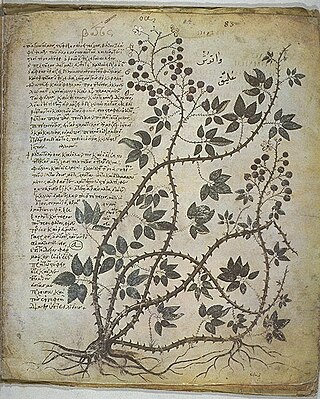
Materia medica is a Latin term from the history of pharmacy for the body of collected knowledge about the therapeutic properties of any substance used for healing. The term derives from the title of a work by the Ancient Greek physician Pedanius Dioscorides in the 1st century AD, De materia medica, 'On medical material'.

William Turner was an English divine and reformer, a physician and a natural historian. He has been called “the father of English botany”. He studied medicine in Italy, and was a friend of the great Swiss naturalist, Conrad Gessner. He was an early herbalist and ornithologist, and it is in these fields that the most interest lies today. He is known as being one of the first “parson-naturalists” in England.

Leonhart Fuchs, sometimes spelled Leonhard Fuchs and cited in Latin as Leonhartus Fuchsius, was a German physician and botanist. His chief notability is as the author of a large book about plants and their uses as medicines, a herbal, which was first published in 1542 in Latin. It has about 500 accurate and detailed drawings of plants, which were printed from woodcuts. The drawings are the book's most notable advance on its predecessors. Although drawings had been used in other herbal books, Fuchs' book proved and emphasized high-quality drawings as the most telling way to specify what a plant name stands for.

A herbal is a book containing the names and descriptions of plants, usually with information on their medicinal, tonic, culinary, toxic, hallucinatory, aromatic, or magical powers, and the legends associated with them. A herbal may also classify the plants it describes, may give recipes for herbal extracts, tinctures, or potions, and sometimes include mineral and animal medicaments in addition to those obtained from plants. Herbals were often illustrated to assist plant identification.
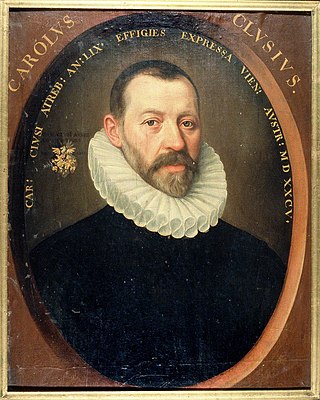
Charles de l'Écluse,L'Escluse, or Carolus Clusius, seigneur de Watènes, was an Artois doctor and pioneering botanist, perhaps the most influential of all 16th-century scientific horticulturists.
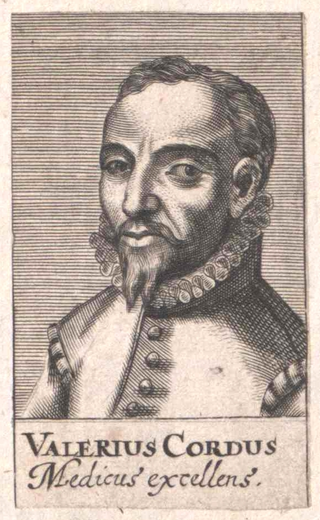
Valerius Cordus was a German physician, botanist and pharmacologist who authored the first pharmacopoeia North of the Alps and one of the most celebrated herbals in history. He is also widely credited with developing a method for synthesizing ether.

Johann Beckmann (1739–1811) was a German scientific author and coiner of the word technology, to mean the science of trades. He was the first man to teach technology and write about it as an academic subject.
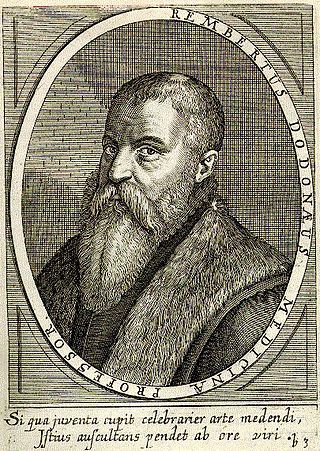
Rembert Dodoens was a Flemish physician and botanist, also known under his Latinized name Rembertus Dodonaeus. He has been called the father of botany. The standard author abbreviation Dodoens is used to indicate this person as the author when citing a botanical name.

Johannes Oporinus was a humanist printer in Basel.

Pietro Andrea Gregorio Mattioli was a doctor and naturalist born in Siena. His most important work was a commentary on the medicinal plants of Pedanius Dioscorides first published in 1544 which was translated into several languages and went into thirteen editions in his lifetime.

Pierre Magnol was a French botanist. He was born in the city of Montpellier, where he lived and worked for most of his life. He became Professor of Botany and Director of the Royal Botanic Garden of Montpellier and held a seat in the Académie Royale des Sciences de Paris for a short while. He was one of the innovators who devised the botanical scheme of classification. He was the first to publish the concept of plant families as they are understood today, a natural classification of groups of plants that have features in common.

Georg Joseph Kamel was a Jesuit missionary, pharmacist and naturalist known for producing the first comprehensive accounts of Philippine flora and fauna and for introducing Philippine nature to the European learned world. A number of Kamel's treatises were published in the Philosophical Transactions, while his descriptions of Philippine flora appeared as an appendix to the third volume of John Ray's Historia Plantarum.

Georg Hartmann was a German engineer, instrument maker, author, printer, humanist, priest, and astronomer.

Botanical illustration is the art of depicting the form, color, and details of plant species. They are generally meant to be scientifically descriptive about subjects depicted and are often found printed alongside a botanical description in books, magazines, and other media. Some are sold as artworks. Often composed by a botanical illustrator in consultation with a scientific author, their creation requires an understanding of plant morphology and access to specimens and references.

Adam Lonicer, Adam Lonitzer or Adamus Lonicerus was a German botanist, noted for his 1557 revised version of Eucharius Rösslin's herbal.

The history of botany examines the human effort to understand life on Earth by tracing the historical development of the discipline of botany—that part of natural science dealing with organisms traditionally treated as plants.
Euricius Cordus born Heinrich Ritze was a German humanist poet, physician, botanist and naturalist. He is considered one of the founders of botany in Germany.
References
- ↑ Allen, George (November 1952). "The History of the Use of the Tomato: An Annotated Bibliography". Annals of the Missouri Botanical Garden. 39 (4): 291. doi:10.2307/2399094. JSTOR 2399094.
- ↑ Kivelson, Margaret G.; Russell, Christopher T., eds. (1995). Introduction to Space Physics . Cambridge University Press. pp. 3–5. ISBN 0-521-45714-9.
- ↑ Jonkers, Art R.T. (2004). "Erdmagnetismus zur Zeit der Seefahrer" (PDF). Physik Journal: 55–59. Archived from the original (PDF) on 2005-09-09. Retrieved 2011-04-20.
- ↑ Klemm, H. G. (1990). Georg Hartmann aus Eggolsheim (1489–1564): Leben und Werk eines fräkischen Mathematiker und Ingenieurs. Wissenschaftliche und künsterlische Beiträge, Ehrenburg-Gymnasium Forscheim, Heft 8. Forscheim.
{{cite book}}: CS1 maint: location missing publisher (link) - ↑ Klemm, Hans Gunther (1994). Magnetismus-Beobachtungen Bei Den Humanistischen Mathematikern Georg Hartmann und Georg Joachim Rheticus. Erlangen.
{{cite book}}: CS1 maint: location missing publisher (link) - ↑ Ball, W. W. Rouse (1908). A Short Account of the History of Mathematics. Macmillan and Co. p. 216.
- ↑ Groza, Vivian Shaw; Shelley, Susanne M. (1972). Precalculus Mathematics. Ardent Media. p. 182. ISBN 978-0-03-077670-0.
- ↑ "Joseph Du Chesne (Sieur de la Violette, 1544-1609)". data.bnf.fr. Bibliothèque nationale de France. Retrieved 23 December 2020.